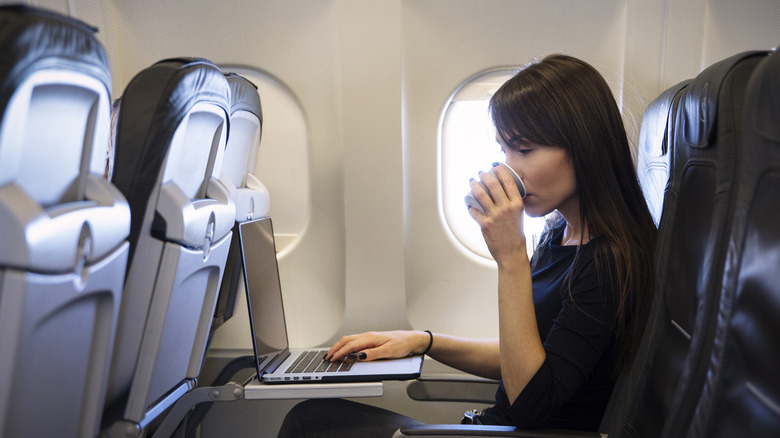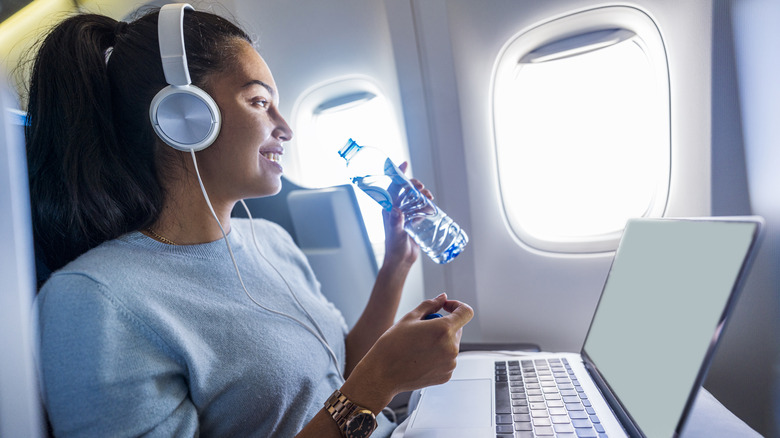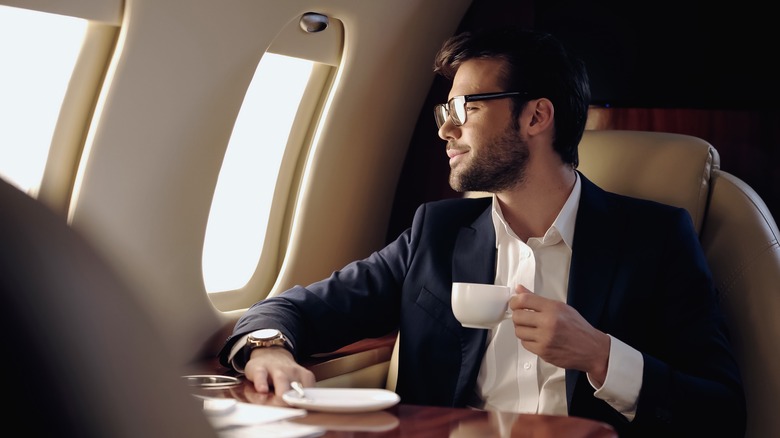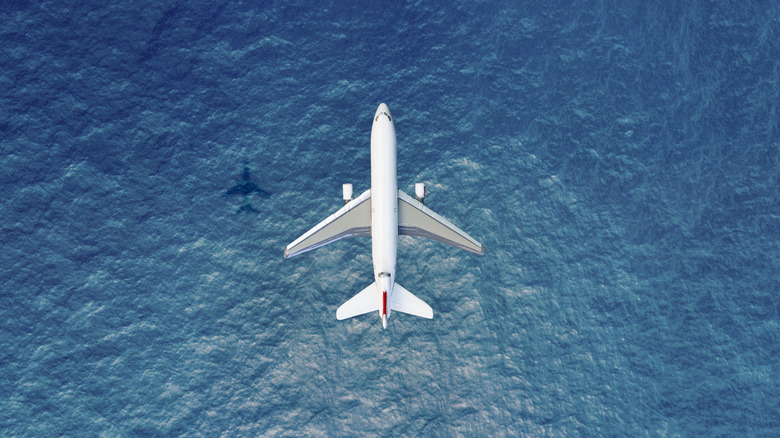Our Doctor Shares The Safest Drinks You Can Order On A Plane (And What To Avoid)
For most people, having a wide selection of beverages and meals is one of the highlights of traveling on an aircraft. But, turns out, there are some drinks you should avoid.
Most of it has to do with the cleanliness of drinking water onboard. The water that is stored in airplane tanks goes through a few stages of transference before it makes it onto the plane — from the public water system to the storage facility, from the facility to a water service vehicle, and then onto the plane's water tank. Each stage opens the water up for contamination.
A 2019 study across 10 major and 13 regional airlines — which tested variables such as fleet size, Aircraft Drinking Water Rule (ADWR) violations, and positive E. coli and coliform in water — revealed that a considerable number of airlines tested lower than 3.0 out of a maximum of 5 points, which was the cutoff for relatively safe drinking water.
A 2015 study published in the International Journal of Environmental Health and Public Health found that water safety on long-haul flights was more concerning than short-haul travel. Chief Medical Officer and Physician at One Oak Medical, Dr. Jason Singh, told Health Digest that "random samples [in this study] found coliform bacteria such as E.coli in 14% of tested aircraft water tanks which are used to brew coffee and tea thereby increasing risk of using contaminated water. These types of bacteria have potential to cause bacterial gastroenteritis in high risk immunocompromised individuals where the most common symptoms include diarrhea, vomiting, and abdominal pain," he explained.
Here's a list of the safest beverages (and what you should avoid).
Stick with bottled water
While it might sound boring, it is safest to stick with sealed water bottles, shared Dr. Singh. Sealed cans and bottles of soda are also okay. "Keep in mind that although it's a safer alternative, these have high sugar content so perhaps consider low-sugar options such as cranberry or tomato juice," he added.
Tea is fine too as long as you make it yourself and you use hot water, per Dr. Singh.
If you're a fan of drinking alcohol on a plane, there's no need to completely cut that out but do bear in mind that dehydration is a bigger concern when you're 42,000 feet in the air, mainly owing to the dry cabin air, shared board-certified general surgeon Dr. Shawn Tsuda (via Insider). Plus, "because of the lower level of oxygen in your blood while flying, you may seem drunker in the air than you would on the ground after consuming the same amount of alcohol," added Dr. Tsuda.
For choices of alcoholic beverages, anything with a stronger flavor profile is the safe bet, Chicago-based licensed dietician nutritionist Lauren Grosskopf told Travel + Leisure. This has more to do with enjoying your drink than anything else. Things you may not consciously think about — like cabin pressure, noise, and tiredness — can affect your sense of taste, so good options include citrus, ginger, and tomato. She did caution, however, that those with sensitive stomachs should limit their intake of acidic drinks.
Avoid coffee made inflight and plane water
Avoid plane water, stressed Anton Radchenko, a licensed attorney and founder of AirAdvisor (via Mirror). And, for that same reason, avoid coffee made on board the aircraft.
The reason to think twice about drinking coffee on a plane, apart from the dehydration aspect we discussed before, is the questionable state of coffee machines. While some flight attendants have brought attention to just how rarely coffee machines are cleaned, aviation industry professional Bobby Laurie told Insider, "The coffee makers are made to be removable and easy to replace it, but the only time they're removed is when they break which is rare. Only the tray where the coffee bag goes and the actual coffee pot is ever removed and cleaned for any reason. The coffee bags are thin. So, if a bag bursts, the flight attendants clean the tray in the bathroom sink."
Again, if you really want a cup of coffee on board, you might be better off carrying some instant coffee sachets with you or asking for hot water so you can fix yourself a cup.
How is airline water safety regulated?
All this talk of what's safe and what's not safe to drink while onboard can get your head swimming with the entire concept of hygienic travel. Shouldn't there be more regulation with something as basic as water? Why should passengers be avoiding a basic human necessity like water served on a plane?
The ADWR, which is jointly regulated by the U.S. Environmental Protection Agency (EPA), Food and Drug Administration (FDA), and Federal Aviation Administration (FAA), mandates that airlines disinfect and clean their water tanks at least four times a year. However, Charles Platkin, executive director at the Center for Food as Medicine and researcher behind the airline water safety study of 2019, told Well+Good that "these regulations have no bite."
Also, laws vary outside the U.S. For Vance Hilderman, chief technical officer of aviation development and certification company Afuzion, modern airplanes filling water from developed and well-regulated countries are considered "100%" safe, while the same cannot be said for less regulated places (via USA Today).
Finally, the proof should be in the pudding, so to speak. "If you get a stomach infection, food poisoning, something like that, it's generally fairly traceable. We could do the same thing on an aircraft, and that would be all over the news, but it's apparently quite rare," shared Hilderman. Ultimately, how safe you want to be and what drinks you want to avoid is up to you. Perhaps this information will help you decide.




